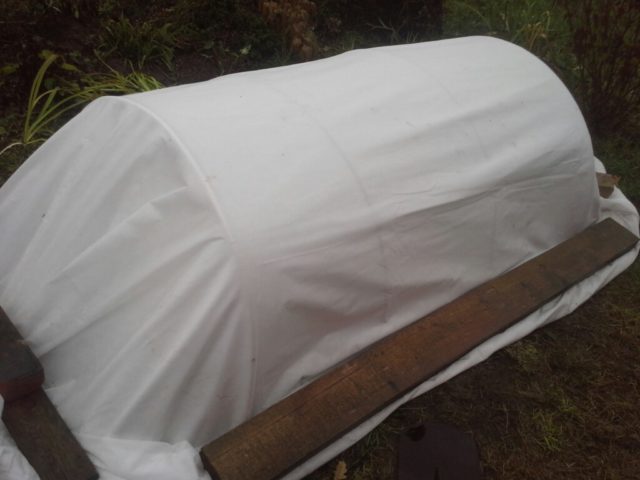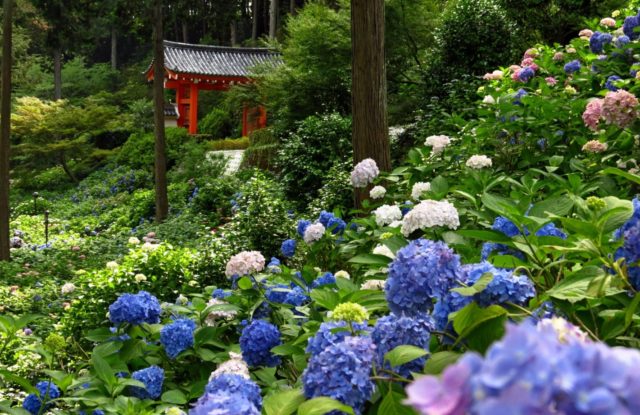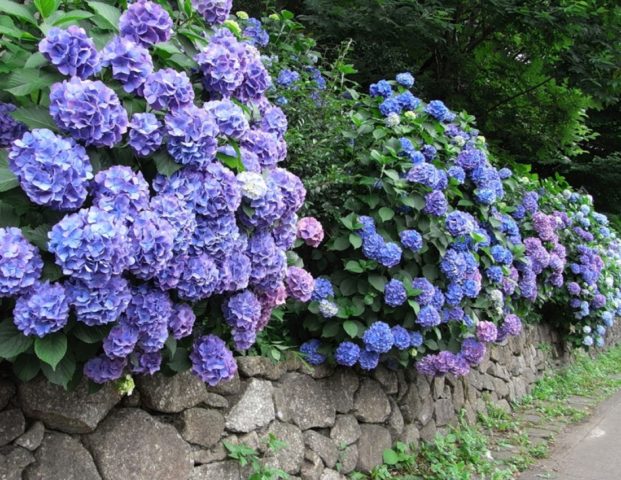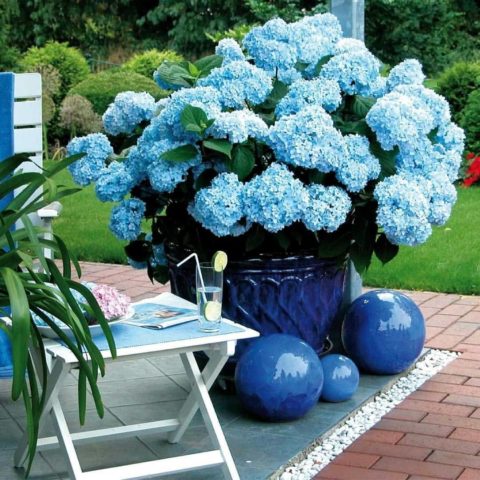Content
Hydrangea Nikko Blue is a species of the Hydrangia genus. The variety was bred for cultivation in climatic conditions with winter temperatures not lower than -22 0C. An ornamental plant with long flowering is used for the design of gardens, backyards, urban areas. The culture is whimsical in care, it requires adherence to agricultural techniques that correspond to the biological needs of the species.
Description of hydrangea Nikko Blue
The main distribution is South and East Asia. Heat-loving wild-growing species formed the basis of hybrid varieties adapted to temperate climates. The most popular is the large-leaved hydrangea, which includes Nikko Blue. This is a perennial herbaceous shrub that grows up to 2 m in height, with a dense compact crown, completely covered with large globular inflorescences.
The Nikko Blue hydrangea blooms for a long time: from June to the end of August. Inflorescences are formed on the top of the shoots of the current year, perennials become lignified and are the basis of the shrub. The ancestor of the variety was a wild-growing species with a white color of flowers, therefore Nikko Blue hydrangea at the beginning of flowering is white, then becomes blue, eventually darkens to a different shade of blue. Inflorescences are corymbose, reaching 20 cm in diameter.

The flowers are large, four-petaled, with a beige or yellowish color in the center
It is difficult to delineate the clear boundaries of the color scheme of a plant.
In an open area, the inflorescences will be brighter. If the acidity of the soil is closer to alkaline, Nikko Blue's hydrangea is light blue, with medium acidity it is dark blue, on neutral soil it is light pink.
The foliage of the herbaceous shrub is intense, the leaves are lanceolate, large, with finely toothed edges and a corrugated surface. The leaf plate is delicate green. By the end of summer, a yellowish tint appears. The plant sheds its foliage before the onset of frost.
Hydrangea Nikko Blue in landscape design
Hydrangea Nikko Blue is characterized by long flowering and voluminous pale green habit; it is widely used in ornamental gardening. Combines well with flowering and evergreens. A few examples of landscape design using Nikko Blue hydrangea:
- Group planting with hydrangeas of different colors to separate the zones of the garden.
Instances with different colors bloom at the same time
- As a tapeworm in the foreground of the site.
Lawn accent color
- As part of a hedge in combination with evergreen shrubs.
A hedge along the path of the city square
- Planted in flower pots to decorate a closed recreation area.
Hydrangea Nikko Blue in the design of a summer veranda
A flowering plant also feels comfortable in indoor conditions.
Winter hardiness of Nikko Blue hydrangea
Winter hardiness of the culture is low: within -18 0C, which corresponds to the sixth climatic zone, in Russia it is the Black Sea coast, Krasnodar and Stavropol Territories.
The central regions are in the fourth climatic zone, where the average winter temperature is -25 0C and below. It is possible to grow Nikko Blue hydrangea here only in pots, which are left in the open in summer, and brought into the room before frost.
Planting and caring for Nikko Blue hydrangea
The crop will not bloom if agricultural technology does not meet the requirements. When planting, take into account the composition of the soil, the location of the site allocated for the Nikko Blue hydrangea. By winter, the plant is pruned and shelter measures are carried out. They are planted in spring and autumn, preferably at the beginning of the growing season, over the summer the hydrangea will get stronger and endure the winter more easily.
Selection and preparation of the landing site
The plant will have a decorative appearance with the right place for planting. The culture is characterized by low drought resistance, it needs constant watering, but it will not grow in a swampy area, since it does not tolerate stagnant moisture. The site must be well drained.
The heat-loving hydrangea cannot grow without light. In the shade, the stems are elongated, the flowering is scattered, rare, the inflorescences are small, dull in color. Hydrangea does not respond well to direct sunlight at midday. The planting site is determined with partial shading, located behind the wall of the building or not far from low bushes, but taking into account that there is enough ultraviolet radiation for the flowering plant in the morning and evening.
The root system of the species is superficial, therefore, close proximity of other crops with the same type of root is not desirable; due to competition, hydrangea may not receive nutrients in insufficient quantities. This factor will primarily affect the decorative effect of the shrub.
Particular attention is paid to the composition of the soil. Herbaceous shrubs will not grow on calcareous soil. With a neutral indicator, the vegetation of the aboveground mass is normal, with good stem formation, but it will not work to achieve a blue color of flowers. The inflorescences will turn out to be pale pink. Slightly acidic soil is the best option for a seedling. If necessary, the indicator is adjusted by making appropriate funds.
Landing rules
Work is carried out in the spring, when the earth warmed up to 15 0C and higher (approximately at the end of May). It is better to plant a crop on the site with seedlings that are at least two years old.

You can buy planting material in a nursery or grow from seeds.
Landing scheme:
- They make a pit 60 * 60 cm in size.
- You can put coniferous litter on the bottom, it will acidify the soil, sprinkle it with soil on top.
- Mix in equal parts sod layer with compost and peat, add 50 g of superphosphate.
- Pour the substrate into the well and fill it with water (10 l).
- Hydrangea is placed vertically (in the center) and covered with earth.
After the completion of the work, the soil is not compacted, but re-watered with water. Cover the root circle with last year's needles, the mulch will maintain moisture and acidify the soil.
Watering and feeding
Hydrangea Nikko Blue is moisture-loving, watering it is vital, but waterlogging can lead to negative consequences. There is a threat of decay of the root system and the development of a fungal infection. Watering is carried out depending on the precipitation. For normal vegetation, the plant needs 15 liters of water for five days.
The first year the plant is not fed, it has enough nutrient mixture introduced during planting. For the next season, they are guided by the inflorescences, if there are few of them and they are small, they immediately apply funds containing potassium sulfate and superphosphate. This means that the soil on the site is not fertile and there is not enough nutrition for Nikko Blue's hydrangea. In subsequent years, in early spring, the bush is fertilized with Agricola, during flowering with Kristalon.
Pruning hydrangea large-leaved Nikko Blue
In regions with a cold climate, Nikko Blue hydrangea is pruned in the fall, this is necessary in order to better cover it for the winter.In the south, cosmetic pruning is done in the spring. Dry inflorescences lose their color, but retain their shape well; against the background of snow, the plant looks quite aesthetically pleasing.
Sequence of work:
- All inflorescences are cut off.
- Leave shoots of one year so that there are at least six vegetative buds from below. If there are more of them, it will be difficult to cover the crown, the plant may die.
- Old stems are removed completely.
The bush is formed by 12-15 shoots. In warmer climates, more buds can be left on annual stems, each of which will sprout and form an inflorescence in spring. The height of the bush will be higher. If the plant hibernates in stationary conditions, pruning is carried out after the bush has lost its decorative effect. The height is adjusted as desired.
Shelter for the winter hydrangeas Nikko Blue
Cover the crop growing in the open field when the temperature drops to zero. The main task is to preserve the root and part of the vegetative buds.
Shelter culture technology:
- The remaining leaves are cut from the plant, the stems are pulled together with a rope.
- The root is spud and covered with a thick layer of mulch, you can take any material: needles, straw, sawdust. It must be dry.
- Around from stakes or metal rods, a structure is made in the form of a cone, the upper part of the stakes is pulled together, the lower one should cover the root circle.
- The height of the frame should be 15 cm above the tops of the stems.

Any covering material that does not allow moisture to be pulled is pulled onto the structure
The lower part is turned inside out and covered with earth, pressed down with boards, bricks. After the onset of frost, they are covered with spruce branches or covered with snow.
Reproduction
Hydrangea Nikko Blue can be propagated in any way:
- Seeds. Seedlings are grown from the planting material, dived. After reaching 1 year, they are seated in separate pots. The next season is determined for the site. The process is lengthy and not always effective.
- By dividing the bush. If the plant is strong, but thickened and its age is more than 4 years, you can separate a part from the parent bush and transplant, it is better to do this in the spring.
- Layers. In autumn, during pruning, a strong shoot is left, bent to the ground and buried in. In the spring, hydrangea will give a root in place of the buds. When the aerial part appears, the cuttings are separated and transplanted; it is better to do this in spring or summer (until mid-June).
- The best option is grafting. During pruning, cuttings are harvested from the top of the shoots of the current year. They are placed in the ground and placed in a room with a temperature of 15 0C, make sure that the soil does not dry out. In the spring, the material will give sprouts, which are placed in separate containers and taken out to the site in the summer, and returned to the premises for the winter. The next year, the plant is transplanted to the site.
Diseases and pests
The immunity of Nikko Blue hydrangea is weak, gray rot is a particular danger to the plant. The fungus appears as dark spots first on the lower part of the stems, then covers the entire crown, holes subsequently appear in the affected areas. It is unlikely that it will be possible to save the bush, the plant is removed from the site and the soil is disinfected. Powdery mildew is less dangerous, it does not cause the death of the plant, but the bush loses its decorative effect completely. When a disease appears, the bush is treated with fungicides.
Parasitize on culture:
- leaf roll;
- spider mite;
- grape snail;
- aphid;
- shield;
- slugs.
Prevent the appearance of pests with preventive measures.
Conclusion
Hydrangea Nikko Blue is a decorative species with bright lush inflorescences. Flowering continues throughout the summer. The culture is used in ornamental gardening. The Nikko Blue variety requires increased attention, since it is characterized by weak immunity and poor frost resistance. Suitable for growing not only on the site, but also indoors.












